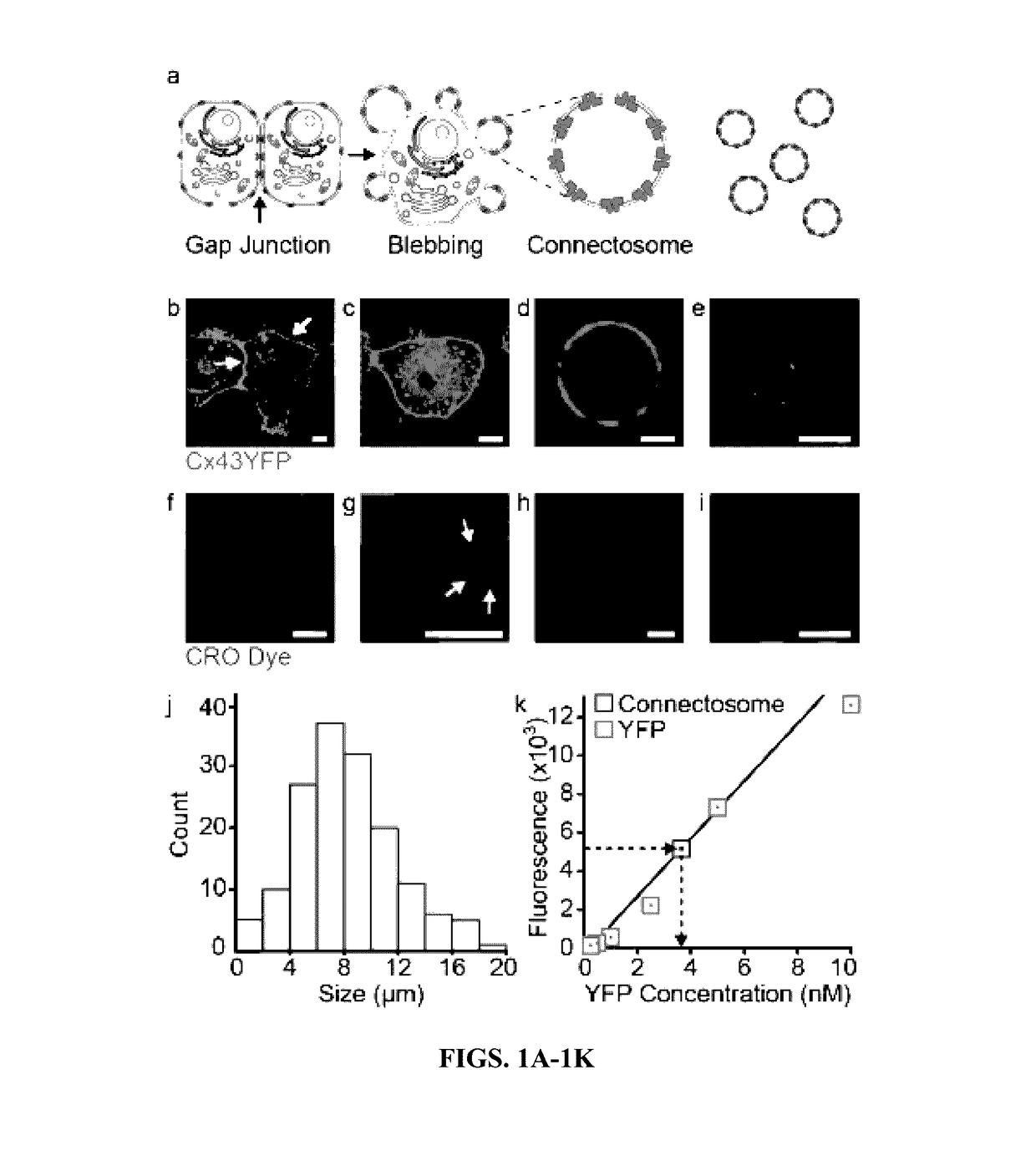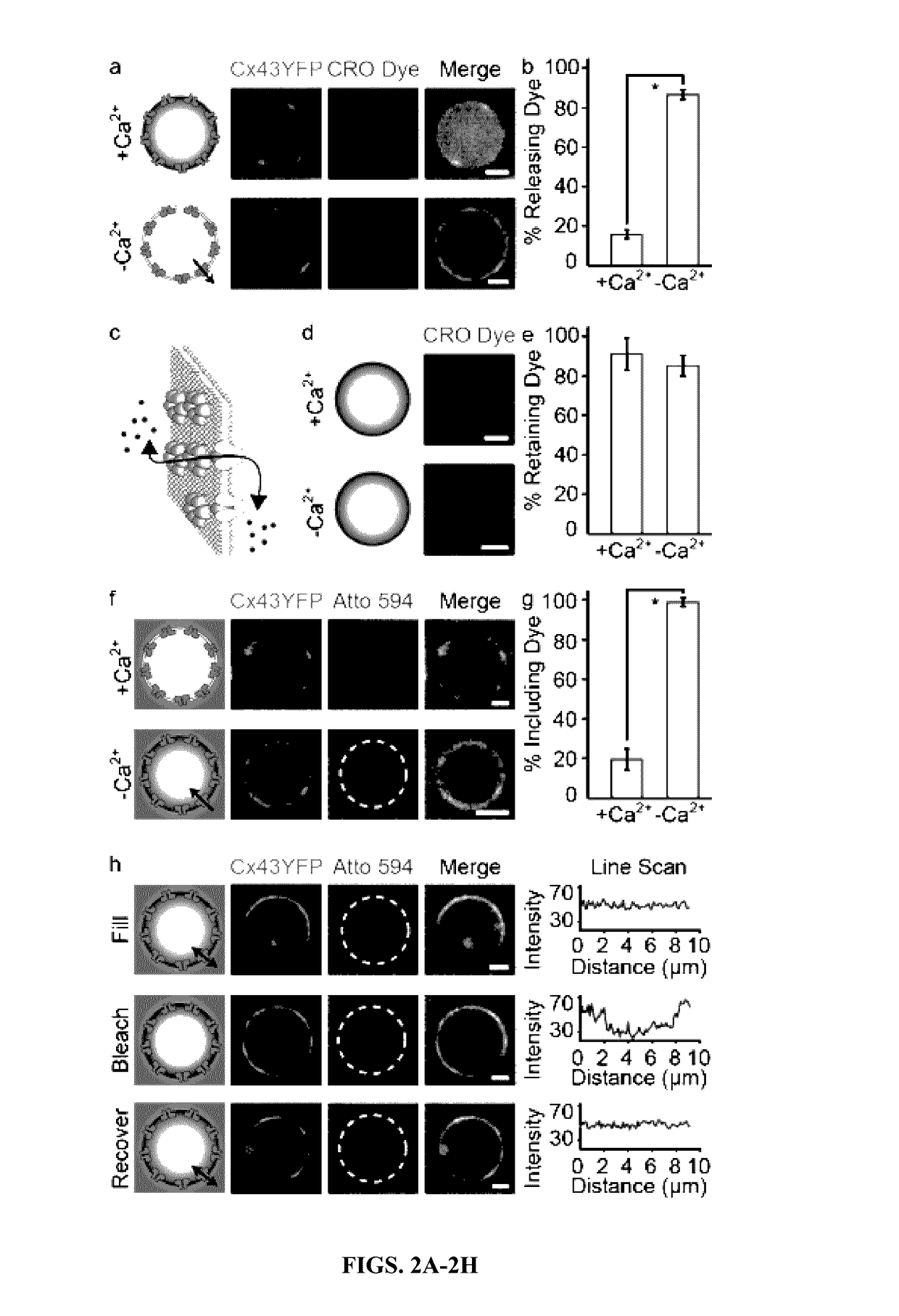Plasma membrane vesicles comprising functional transmembrane proteins
a technology of transmembrane proteins and vesicles, applied in the field of medicine and biology, can solve the problems of limiting the design and application of drugs and reagents across the cell's plasma membrane barrier, and the challenge of delivering them across the membrane barrier remains formidable, and achieves the effect of enhancing or restoring cellular gap junction communication and enhancing or restoring endogenous cftr function
- Summary
- Abstract
- Description
- Claims
- Application Information
AI Technical Summary
Benefits of technology
Problems solved by technology
Method used
Image
Examples
example 1
[0174]Cells use the gap junction network to share small molecules, including metabolites, drugs, and small interfering RNAs, directly with each other. The proteins that form gap junctions are called connexins, and they assemble into hexameric hemichannels called connexons, in the plasma membranes of cells (Andrade-Rozental et al., 2000). When connexon hemichannels within the plasma membranes of two neighboring cells meet, they form a complete gap junction channel that connects the two cells, enabling molecules in the cytoplasm of one cell to diffuse through the channel and into the cytoplasm of a neighboring cell. Gap junctions transfer chemotherapeutics from cell to cell, enabling drug penetration in tumors (Yamasaki et al., 1999). This phenomenon, known as the bystander effect (Fujimoto et al., 1971) promotes the efficacy of a diverse range of chemotherapeutics such as doxorubicin, etoposide, paclitaxel, gemcitabine, and others (Huang et al., 2001). Inspired b...
example 2
very by Gap Junction Vesicles
[0180]Having established the functionality of the connexons, the ability of the Connectosomes to deliver molecular cargo into the cellular cytoplasm was examined (FIG. 3A). While the presence of calcium keeps unpaired connexons closed (Allen et al., 2011), complete channels form and open when two unpaired connexons on the surfaces of neighboring cells meet, even in the presence of physiological levels of extracellular calicium (Sakhtianchi et al., 2013). To test the ability of Connectosomes to form gap junctions with cells, a confluent monolayer of recipient HeLa cells was prepared. CRO dye-loaded Connectosomes were prepared as described above (FIG. 1F-I) and incubated with the recipient cells. Imaging the recipient cells after 2 hours revealed the intracellular accumulation of dye (FIG. 3B, 6). To quantify the CRO dye delivery, the relative fluorescence intensity of the cell populations was measured using flow cytometry (FIG. 3C-E). Exposure to CRO dye-...
example 3
and Methods
[0191]Reagents.
[0192]CellTrace Calcein Red-Orange AM and trypan blue were purchased from Life Technologies. Sodium phosphate, DTT (dithiothreitol), PFA (paraformaldehyde), doxycycline, glycine, Atto 594-NHS ester, imidazole, NaCl, CaCl2, EGTA (ethylene glycol tetraacetic acid), EDTA (ethylenediaminetetraacetic acid), HEPES (4-(2-hydroxyethyl)-1-piperazineethanesulfonic acid), DMSO (dimethyl sulfoxide) and doxorubicin were purchased from Sigma. Fetal bovine serum (FBS), trypsin, penicillin, streptomycin, L-glutamine, PBS (phosphate buffered saline), and DMEM (Dulbecco's modified Eagle medium) were purchased from GE Healthcare. Puromyocin was purchased from Clontech. Geneticin (G418) was purchased from Corning. Leupeptin and pepstatin were purchased from Roche. PMSF (phenylmethanesulfonyl fluoride), β-ME (β-mercaptoethanol) were purchased from Fisher Scientific. 7-AAD (7-amino-actinomycin D) was purchased from Affymetrix eBioscience. All chemical reagents were used without ...
PUM
| Property | Measurement | Unit |
|---|---|---|
| diameter | aaaaa | aaaaa |
| diameter | aaaaa | aaaaa |
| diameter | aaaaa | aaaaa |
Abstract
Description
Claims
Application Information
 Login to View More
Login to View More - R&D
- Intellectual Property
- Life Sciences
- Materials
- Tech Scout
- Unparalleled Data Quality
- Higher Quality Content
- 60% Fewer Hallucinations
Browse by: Latest US Patents, China's latest patents, Technical Efficacy Thesaurus, Application Domain, Technology Topic, Popular Technical Reports.
© 2025 PatSnap. All rights reserved.Legal|Privacy policy|Modern Slavery Act Transparency Statement|Sitemap|About US| Contact US: help@patsnap.com



